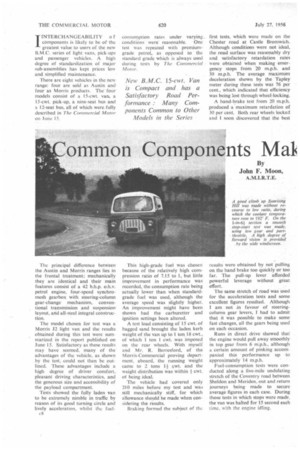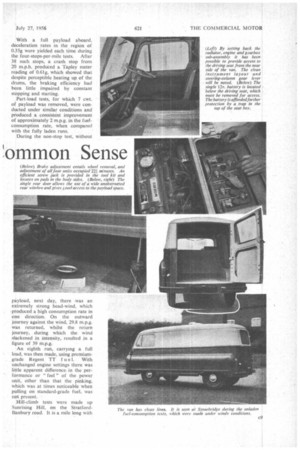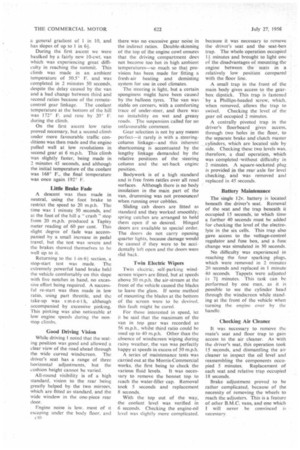ommon Components Mal
Page 46

Page 47

Page 48

Page 49

If you've noticed an error in this article please click here to report it so we can fix it.
'ommon Sense
By John F. Moon,
A.M.I.R.T.E. IINTERCHANGEABILITY o f components is likely to be of the greatest value to users of the new H.M.C. series of light vans, pick-ups and passenger vehicles. A high degree of standardization of major sub-assemblies has kept prices low and simplified maintenance.
There are eight vehicles in the new range: four are sold as Austin and four as Morris products. The four models consist of a 15-cwt. van. a 15-cwt. pick-up, a nine-seat bus and a I2-seat bus, all of which were, fully described in The Commercial Motor on June 15.
The principal difference between the Austin and Morris ranges lies in the frontal treatment; mechanically they are identical and their main features consist of a 42 b.h.p. o.h.v, petrol engine, four-speed synchromesh gearbox with steering-column gear-change mechanism, conventional transmission and suspension layout, and all-steel integral construction.
The model chosen for test was a Morris J2 light van and the results obtained during this test were summarized in the report published on June 15. Satisfactory as these results may have seemed, many of the advantages of the vehicle, as shown by the test, could not then be outlined. These advantages include a high degree of driver comfort. pleasant driving characteristics, and the generous size and accessibility of the payload compartment.
Tests showed the fully laden van to be extremely nimble in traffic by reason of its good turning circle and lively acceleration, whilst the fuel cs consumption rates under varying .
conditions were reasonable. One test was repeated with premiumgrade petra as opposed to the standard grade which is always used during tests by The Commercial Motor.
This high-grade fuel was chosen because of the relatively high compression ratio of 7.15 to 1, but little improvement in performance was recorded, the consumption rate being actually lower than when standardgrade fuel was used, although the average speed was slightly higher. An improvement might have been shown had the carburetter and ignition settings been altered.
A test load consisting of 15 cwt. of bagged sand brought the laden kerb weight of the van up to I ton 18 cwt., of which 1 ton 1 cwt. was imposed on the rear wheels. With myself and Mr. R. Berresford, of the Morris-Commercial proving department. aboard, the running weight came to 2 tons 1+ cwt. and the weight distribution was within + cwt. of being ideal.
The vehicle had covered only 210 miles before my test and wad still mechanically stiff, for which allowance should be made when considering the results.
Braking formed the subject of the first tests, which were made on the Chester road at Castle Bromwich. Although conditions were not ideal, the road surface was reasonably dry and satisfactory retardation rates were obtained when making emergency stops from 20 m.p.h. and 30 m.p.h. The average maximum deceleration shown by the Tapley meter during these tests was 76 per cent., which indicated that efficiency was being lost through wheel-locking.
A hand-brake test from 20 m.p.h. produced a maximum retardation of 30 per cent. Both rear wheels locked and I soon discovered that the best results were obtained by not pulling on the hand brake too quickly or too far. The pull-up lever afforded powerful leverage without great effort.
The same stretch of road was used for the acceleration tests and some excellent figures resulted. Although 1 am not in favour of steeringcolumn gear levers, I had to admit that it was possible to make some fast changes, all the gears being used on each occasion.
Runs in direct drive showed that the engine would pull away smoothly in top gear from 6 m.p.h., although a certain amount of pinking accompanied this performance up • to approximately 14 m.p.h.
Fuel-consumption tests were conducted along a five-mile undulating stretch of the Coventry road between Sheldon and Meriden, out and return journeys being made to secure average figures in each case. During those tests in which stops were made. the van was halted for 15 second each time, with the engine idling. With a full payload aboard, deceleration rates in the region of 0.35g were yielded each time during the four-stops-per-mile tests. After 38 such stops, a crash stop from 20 m.p.h. produced a Tapley meter reading of 0.6Ig, which showed that despite perceptible heating up of the drums, the braking efficiency had been little impaired by constant stopping and starting.
Part-load tests, for which 7 cwt. of payload was removed, were conducted under similar conditions and produced a consistent improvement of approximately 2 m.p.g. in the fuelconsumption rate, when compared with the fully laden runs.
During the non-stop test, without payload, next day, there was an extremely strong head-wind, which produced a high consumption rate in one direction. On the outward journey against the wind, 29.8 m.p.g. was returned, whilst the return journey, during which the wind slackened in intensity, resulted in a figure of 39 m.p.g.
An eighth run, carrying a full load, was then made, using premiumgrade Regent Ti' f u el. With unchanged engine settings there was little apparent difference, in the performance or "feel" of the power unit, other than that the pinking, which was at times noticeable when pulling on standard-grade fuel, was not present.
Hill-climb tests were made up Sunrising Hill. on the StratfordBanbury road. It is a mile long with a general gradient of 1 in 10, and has slopes of up to 1 in 61.
During the first ascent we were baulked by a fairly new 10-cwt. van which was experiencing great difficulty in reaching the summit. This climb was made in an ambient temperature of 50.5° F. and was completed in 2 minutes 50 seconds, despite the delay caused by the van and a bad change between third and second ratios because of the remotecontrol gear linkage. The coolant temperature at the bottom of the hill was 172° F. and rose by 20° F. during the climb.
On the first ascent low ratio proved necessary, but a second climb tinder more favourable traffic conditions was then made and the engine pulled well at low revolutions in second gear at 6 m.p.h. This climb was slightly faster, being made in 2 minutes 45 seconds, and although the initial temperature of the coolant was 168° F., the final temperature was once again 192° F.
Little Brake Fade
A descent was then made in neutral, using the foot brake to restrict the speed to 20 m.p.h. The time was 1 minute 50 seconds, and at the foot of the hill a "crash "stop from 20 m.p.h. produced a Tapley meter reading of 60 per cent. This slight degree of fade was accompanied by a small increase in pedal travel, but the test was severe and the brakes showed themselves to be well up to it.
Returning to the 1-in-61 section. a stop-start test was made. The extremely powerful hand brake held the vehicle comfortably on this slope with five notches in hand, no excessive effort being required. A successful re-start was then made in low ratio. using part throttle, and the take-up was smoot h. although accompanied by excessive pinking_ This pinking was also noticeable at low engine speeds during the nonstop climbs.
Good Driving Vision
While driving I noted that the seating position was good and allowed a clear view of the road ahead through the wide curved windscreen. The driver's seat has a range of three horizontal adjustments, but the cushion height cannot be varied.
All-round visibility is of a high standard, vision to the rear being greatly helped by the two mirrors, which are fitted as standard, and the wide window in the one-piece rear door.
Engine noise is low, most of it escaping under the body floor. anti (10 there was no excessive gear noise in the indirect ratios. Double-skinning of the top of the engine cowl ensures that the driving compartment does not become too hot in high ambient temperatures—so much so that provision has been made for fitting a fresh-air heating and demisting system for use in cool climates.
The steering is light, but a certain sponginess might have been caused by the balloon tyres. The van was stable on corners, with a comforting trace of under-steer, and there was no instability on wet and greasy roads. The suspension called for no unfavourable comment.
Gear selection is not by any means perfect—it rarely is with a steeringcolumn linkage—and this inherent shortcoming is accentuated by the lengthy linkage demanded by the relative positions of the steering column and the set-back engine position.
Bodywork is of a high standard and is free from rattles over all road surfaces. Although there is no body insulation in the main part of the van, drumming was not pronounced when running over cobbles.
Sliding cab doors are fitted as standard and they worked smoothly; spring catches are arranged to hold them open if so desired. Hinged doors are available to special order. The doors do not carry opening quarter lights, because damage would be caused if they were to be accidentally left open and the doors were slid back.
Twin Electric Wipers
Twin electric, self-parking windscreen wipers are fitted, but at speeds above 50 m.p.h. the air-stream at the front of the vehicle caused the blades to leave the glass. If some method of mounting the blades at the bottom of the screen were to be devised, this fault might be cured.
For those interested in speed, let it be said that the maximum of the van in top gear was recorded as 56 m.p.h.. whilst third ratio could be used up to 40 m.p.h. Other than the absence of windscreen 'wiping during rainy weather, the van was perfectly happy at speeds in excess of 50 m.p.h.
A series of maintenance tests was carried out at the Morris-Commercial works, the first being to check the
various fluid levels. It was necessary to remove the bonnet top to reach the water-filler cap. Removal took 5 seconds and replacement 8 seconds.
With the top out of the way, the coolant level was verified in 6 seconds. Checking the engine-oil level was slightly more complicated. because it was necessary to remove the driver's seat and the seat-box trap. The whole operation occupied If minutes and brought to light one of the disadvantages of mounting the engine between the seats in a relatively low position compared With the floor line.
A small trap in the front of the main body gives access to the gearbox dipstick. This trap is fastened by a Phillips-headed screw, which, when removed, allows the trap to swivel. Checking the level of the gear oil occupied 2 minutes.
A centrally pivoted trap in the driver's floorboard gives access, through two holes in the floor, to the separate brake and clutch master cylinders, which are located side by side. Checking these two levels was. therefore, a dual operation, which was completed 'without difficulty in 2 minutes. A square-socketed plug is provided in the rear axle for level checking, and was removed and replaced in 45 seconds.
Battery Maintenance
The single 12v. battery is located beneath the driver's seat. Removal of the seat and the trap beneath it occupied 15 seconds, to which time a further 40 seconds must be added for checking the level of the electrolyte in the six cells. This trap also gave access to the voltage-control regulator and fuse box, and a fuse change was simulated in 30 seconds.
No difficulty was experienced in reaching the four sparking plugs, which were removed in 2 minutes 20 seconds and replaced in 1 minute 40 seconds. Tappets were adjusted ii 7-1minutes. This task can be performed by one man, as it is possible to see the cylinder head through the windscreen while standing at the front of the vehicle when turning the engine over by the handle.
Checking Air Cleaner
It was necessary to remove the mate's seat and floor trap to gain access to the air cleaner. As with the driver's seat, this operation took 15 seconds, and dismantling the air cleaner to inspect the oil level and reassembling the components occupied 5 minutes. Replacement of each seat and relative trap occupied 18 seconds.
Brake adjustment proved to be rather complicated, because of the necessity of removing the wheels to reach the adjusters. This is a feature of other B.M.C. vans, and one which I will never be convinced is necessary The job was made slightly less difficult, however, by the efficient jacking system. A screw jack is provided with the tool kit and locates on pads at the centre of the body on each side.
The mechanical advantage provided by this jack is high, and it was a relatively light job to lift up the side of the van sufficiently to clear both wheels off the ground. The total time taken to adjust the four brakes was 22+ minutes: with a simple method of adjustment, experience has shown that this job would normally take less than 5 minutes.
Because of the extensive use of rubber bushes, greasing is limited to three Points on the propeller shaft. one on the hand-brake compensator linkage, and the usual points on the steering linkage and swivel pins. Underfloor maintenance is thus reduced to a minimum.
It is in respect of engine maintenance that the new vehicles will cause most concern to service engineers. The engine position permits access to the driving seat from each cab door, but it is neither far enough back to accommodate a comfortable third seat nor high enough to give easy access to the engine accessories. This feature is common to other vans in this category.
The method of mounting is such that engine removal is relatively easy, which leads me to wonder whether it would save time to withdraw the engine when several maintenance jobs have to be done.
The van sells at a basic price of £478 and, in Great Britain, carries £73 13s. 6d. purchase tax. Optionai extras include a passenger seat, which is standard on export vehicles, and spare wheel. As tubeless tyres are fitted as standard, it is not considered necessary to offer a spare wheel as a basic accessory.
The new B.M.C. van is the first British design to offer a serious challenge to Continental vehicles of this type. In common with such vehicles it has many running units which are employed also in B.M.C. private cars.












































































































